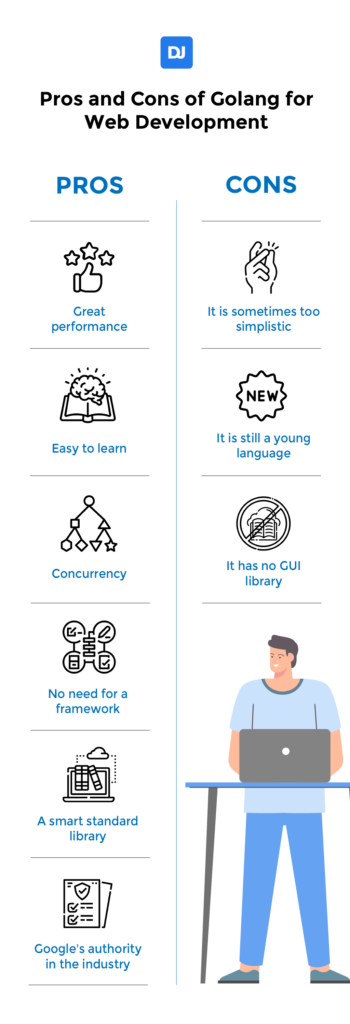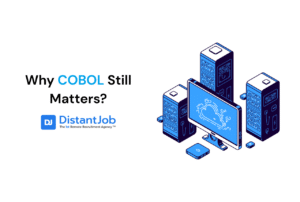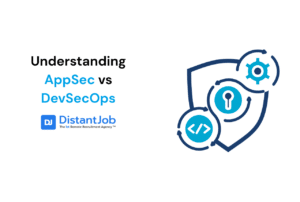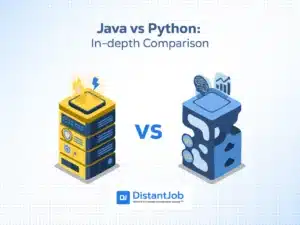Web development is a dynamic field with new languages, frameworks, and libraries introduced every year to improve programming efficiency and practices. Golang is one such language, created by Google, that improves upon existing languages like Python, C, & more. This has made Golang web development a great option for many new applications! In 2023, Go was in 10th place; in 2024, it was in 8th place, and in 2025, Go rose to the 7th rank of popular programming languages. However, Golang shouldn’t be a junior’s only programming language, at least not for now!
This guide will highlight Go’s strengths—its minimalist syntax, lightning-fast compilation, and goroutine-powered concurrency. We’ll explore top-tier frameworks like Gin, Echo, Fiber, and Beego that simplify building REST APIs and microservices. We’ll also examine the trade-offs, such as Go’s pros, cons, and features, so you can confidently choose if it’s the right tech stack for you and your project.
What is Golang?
Golang is a statically typed, compiled programming language created by Google. With statically typed languages, type checking is done during compile-time instead of runtime.
Golang combines older frameworks’ good properties such as Python, C, and more and puts them together into one package. Such properties include static typing and runtime for languages like C# and uncomplicated syntax for languages like Python and JavaScript. For the past 12 years, Go has been improved by adding new capabilities to make it a complete programming language.
Top Go Web Frameworks
Before we look at the best web frameworks for Golang, we must consider whether we need any frameworks in the first place.
The Go programming language was designed with simplicity in mind. This means that you don’t need to use a web framework in order to create a Golang website or web applications in Go.
However, there are many benefits to using a web framework, such as increased productivity, a more structured codebase, and access to a wide range of libraries and tools.
There are several Golang web frameworks for different use-cases. Here are the top five you can choose:
1. Gin

Gin is one of the best web frameworks for Golang. It is mainly used to build microservices. This framework has over 54k ratings on GitHub. It is used for this purpose because it makes it possible to build a request-handling pipeline to plug in middleware. Some of the top features of Gin include; error management, great performance, and creating middleware.
2. Echo

Echo is a relatively newer Go web framework when compared to Gin. However, it is very promising, and for the time it has been around, over 20k GitHub users have given this framework a star. Echo is ideal for people who want to build APIs from scratch due to its well-articulated documentation that is very easy to follow. Its features include letting developers define their own middleware and supporting HTTP/2.
3. Beego

Beego is also a popular Go framework mainly used to build enterprise-level web applications with rapid development. This Golang framework has four major parts: base modules, web server, tasks, and clients. The major features of Beego include support for enterprise applications and namespace routing. Like popular frameworks like Django, Beego also uses the MVC architecture to handle specific development aspects of an app.
4. Iris

Iris is also a popular GO web framework with over 20k stars on GitHub. This framework is equivalent to Express.js and ideal for people using Node.js. Some of the core features of Iris include; a built-in logger for printing and logging server requests, supports MVC architecture, a faster performance due to smart and fast compression, and also fully accordant and flexible with external libraries.
5. Fiber

Just like Iris, Fiber is also an Express.js-equivalent framework. One of its key benefits is low memory usage and rich routing. Some of the core features of this framework include; a built-in rate limiter, versatile middleware support, and support for WebSocket bidirectional TCP connections.
Solutions with Go- What Kind of Go Web Applications You Can Build?
Golang can be used to create various types of web applications, from lightweight REST APIs and microservices to real-time streaming platforms, e-commerce backends, static site generators, and infrastructure tools. Major companies like Uber, Twitch, Monzo, Dropbox, and PayPal rely on Go for its performance, simplicity, and fast compile times. However, these are some of the solutions that Golang is ideal for.
Real-Time & Streaming Platforms
Go powers demanding, real-time applications. Twitch employs Go to manage live video ingestion and chat at massive scale, improving garbage-collection performance twentyfold for smoother user experiences. Similarly, Uber’s location services and dynamic pricing engines leverage Go’s goroutines for concurrent request handling
API & Microservices
Go’s standard library (net/http) and minimal runtime overhead are perfect for building RESTful APIs and microservices that need to handle high volumes of requests with low latency. Companies such as Uber use Go for core services like geofencing, benefiting from Go’s concurrency primitives to serve millions of users with 99.99% uptime
E-commerce & Financial Systems
High-throughput e-commerce backends and fintech platforms often choose Go for its reliability under load. Monzo’s banking app and Allegro’s online marketplace rely on Go to process transactions securely and at scale. PayPal and other financial giants implement Go to power payment processing and credit-offers APIs, taking advantage of Go’s speed for low-latency, high-availability services.
Content Management & Static Site Generators
Go is the engine behind popular static-site generators and web servers. Hugo enables lightning-fast site builds with minimal configuration, while Caddy provides automatic HTTPS and easy configuration for modern web hosting . The official “Writing Web Applications” tutorial demonstrates how Go’s html/template and routing packages can form the basis of simple CMS-style sites.
Monitoring & Observability Dashboards
Grafana, InfluxDB, and Prometheus use Go to power real-time metrics collection and interactive dashboards. Go’s performance characteristics ensure low-overhead data ingestion and fast query responses, critical for observability in large-scale systems.
Golang Web Development Features
Building web applications is one of the use cases of Go. It is mainly used for server-side scripting, although some developers use it to build frontend web apps frameworks.
Let’s look at some of the features that make this language ideal for web development:
1. Simplicity
One of the core reasons many developers have fallen in love with Go is its simplicity. Unlike other backend development languages that prioritize having lots of features, the priorities of Go are readability and maintainability. The only features added to this language are those that will make it much easier to use and enhance readability and maintainability.
2. Concurrency
In web development, concurrency helps apps take advantage of multiprocessor architecture and handle requests from multiple users simultaneously. Apps built with Go are easier to scale up because of the concurrency capabilities built within them from the ground up.
3. Well stocked standard library
Having a library of pre-written code makes it a lot easier and much faster to write code. Golang’s library may not be as big as Python or Java, but it has most of the essential packages developers need to build functional web applications. And because it has been around for just 12 years, having such a big library is an achievement.
4. System programming and cloud computing
This feature enables Go developers to use this language to create apps deployed on the cloud. Go is also an excellent system-level programming language and has capabilities offered by languages like C.
5. Compilation Speeds
This is one of the benefits that has forced many developers to adopt this language. It is faster to compile code with Go than with many popular programming languages, including Java and PHP. This language and its compiler were all designed while keeping the compilation speed in mind.
Pros and Cons of Golang for Web Development
Go compiles fast into a single, high-performance binary, uses a clean, minimal syntax, and includes everything you need for web services right out of the box. Its built-in goroutines make concurrency simple, and its tooling cuts down on extra libraries. On the flip side, it has fewer web frameworks than Node.js or Python, error handling can feel repetitive, generics are still new, and managing module versions can get tricky. Here are the pros and cons:

Pros
- High Performance & Speed
Go is very smooth and will offer better performance with the same hardware as Python and Java. Go compiles directly to machine code, yielding high runtime performance on par with C++ and Java. Its lightweight compiler drastically reduces build times, speeding up development iterations
- Easy to learn
The simplicity of this programming language makes it extremely easy to learn, no matter the experience one has in web development. Its syntax is even easier to adopt if the developer has prior experience with Java and C. The language also has a large community, making it easier for developers to get solutions from Go-centered forums.
So, in case one gets challenges along the way, they can easily find solutions on platforms including Reddit, Stackoverflow, Quora, YouTube, and many more. Golang’s documentation is also well-articulated and easy to understand. So, it is of great importance if you happen to get stuck along the way.
- Robust Concurrency
Go will divide large programs into smaller tasks and run them simultaneously through goroutines and channels. With this, computers will execute these tasks much faster and spend less idle time. This feature also makes Go the ideal language for building scalable apps whose user base grows exponentially over time.
- No need for a framework
Despite having several Go frameworks, it is possible to build web applications with Go without relying on any framework. Go has an excellent standard library, making it possible to create apps right within without using a framework like most programming languages. So, if you are not a fan of frameworks, Go’s standard library is good enough to get you going.
- Built-in Tooling & Library
Developers using this language can do almost everything without importing any secondary libraries. The standard library includes net/http, html/template, JSON handling, and profiling tools, often eliminating the need for external packages in web projects.
- Single Binary & Cross-Compilation
Go produces a single statically linked binary per target platform, simplifying deployment pipelines, and can cross-compile to different OS/ARCH out of the box
Despite having a lot of benefits over most programming languages for web development, Go also has some drawbacks that we need to talk about.
Cons
- Limited Web Framework Ecosystem
Being simple is at the core of Golang, but sometimes being too simplistic comes at a cost. Compared to ecosystems like Node.js or Django, Go has fewer mature, full-featured web frameworks—most projects rely on minimalist routers (Gin, Echo, Fiber) with community-built middleware.
- It is still a young language
One of the disadvantages of being a new language is that it has fewer niche libraries and SDKs, especially outside core areas like networking and cloud services, requiring more custom development. Being new also affects the number of packages available in the language’s libraries. Go might have a smart standard library, but it is nowhere near what the likes of Java and Python offer.
- Complex Dependency Management
Another major drawback with Go is the fact that it while Go modules have replaced GOPATH, version replacement rules, proxy settings, and transitive dependency conflicts can still create a steep learning curve for teams.
Summing It Up
Go has gained popularity thanks to the many benefits it has over Python, Java, and PHP.
Its simplicity, scalability, maintainability, and concurrency features are some of the reasons over 1.1 million developers chose this language over several other available options.
You can reach out to us to hire software developers for your next Golang web development project, and our team will help you find the expert developers who would also be a culture fit.





